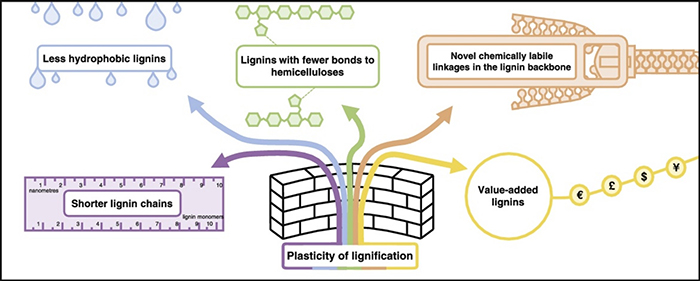

 |
 |
|
|||||||||||||
 GCEP Quarterly Newsletter
Newsletter Sign-Up
News Archive
GCEP Quarterly Newsletter
Newsletter Sign-Up
News Archive
|
For more than a decade, biofuels have been in the news as a potential fuel of the future. During the George W. Bush administration, ethanol made from the sugars of corn kernels became the major biofuel in the U.S., supplying billions of gallons annually. Since then, many questions have been raised about the impact of biofuel production on the environment and the global food supply. As a result, more sustainable and environmentally friendly sources of sugars for biofuels synthesis have been sought. One promising alternative is “cellulosic feedstock,” such as grass and wood, which can be grown on abandoned lands with relatively little water and fertilizer. The woody, non-food part of many plants is a rich source of sugars. But getting sugars out of cellulosic plants requires a certain amount of persuasion – mostly of the chemical, biological and energetic kind, which lowers the energetic output from the plant. In recent years, lignin has become a major focus of cellulosic research. Cellulose, which is pure sugar, is contained in the cell walls of woody plants. Lignin embeds the cellulose in place like cement, giving firmness and rigidity to the plant. Reducing the amount of lignin in plants increases the ease of extraction and enzymatic breakdown of cellulose. However, this can have unwanted consequences for the plant, including susceptibility to pathogens and stunted growth, lowering biomass productivity. Increasing the conversion efficiency of woody biomass while maintaining plant growth and health has become a key goal of biofuel research. In 2008, GCEP scientists set out to tackle this problem. Since then they have made major discoveries in understanding how lignin is synthesized and how to change it for the better. In 2013, GCEP researchers made a significant advance by identifying a new gene in the lignin biosynthetic pathway that, when altered, quadruples the sugars that can be extracted, without pretreatment, from the cell wall. Not only have the researchers met and surpassed the targets in their initial proposals, they also developed many tools and methods for understanding lignin biosynthesis along the way that are now widely used by the research community. For example, it is now possible to visualize individual lignin units in a plant cell and follow the pathway through the cell from genesis to the site of incorporation into a longer polymer in the cell wall. 
Figure 1: Designer lignins can now be made that have fewer bonds to cell wall components,
and shorter chains, as well as other important properties. Today, with a decade’s worth of major advances in lignin research from GCEP researchers and other leaders in the field, scientists have the ability to make designer lignins that can be tailored for easier extraction with low energy inputs and have the potential to be a valuable starting material for chemicals synthesis (Figure 1). The GCEP team members describe the recent advances and current challenges in lignin research in an article published in the February 2016 issue of the journal Current Opinion in Biotechnology. They also continue to conduct GCEP research on optimizing the yield and composition of lignin-modified plants. By Jennifer Milne, Ph.D. - Energy Systems Analyst for Global Climate and Energy Project at Stanford. March 1, 2016 GCEP Fact Sheets: Assembly of a Lignin Modification Toolbox Efficient Biomass Conversion: Delineating the Best Lignin Monomer-Substitutes Novel Mutants Optimized for Lignin, Growth and Biofuel Production via Re-Mutagenesis |
| Restricted Use of Materials from GCEP Site: User may download materials from GCEP site only for User's own personal, non-commercial use. User may not otherwise copy, reproduce, retransmit, distribute, publish, commercially exploit or otherwise transfer any material without obtaining prior GCEP or author approval. |